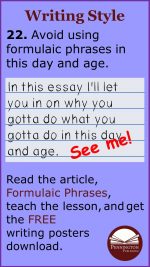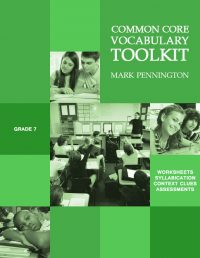Formulaic Phrases
“That was quite the party last night!” Bebe said.
“Yes, a good time was had by all,” Sergio said. “But it was over before it really began.”
“You love your formulaic phrases, Sergio.”
“Once I find something that works, it’s all good.”
Definition and Examples
A formulaic phrase is a commonly used expression. Example: In this day and age, most people know that you can’t be too careful. The formulaic phrase is closely related to an idiom (or idiomatic expression). Example: She walked through the door. Both are considered to be figures of speech.
In both formulaic phrases and idioms, the individual words may not mean exactly what they say. Both types of expressions often suggest, but do not state, certain attitudes. The differences are that the formulaic phrase is considered over-used, but an idiom is not, and the formulaic phrase may shift its wording to suit its purposes, but an idiom does not change.
Read the rule.
Don’t use idiomatic expressions or idioms in essays or reports.
Re-write these sentences and [bracket] the formulaic phrases.
- No one would support that idea. You know what I mean?
- I know what he meant, but these days, you just can’t say that.
- I’ll reconsider what you say, but at the end of the day I’ll have to make my decision.
- We all know what that sort of thing can lead to, don’t we?
- It’s this, that, or the other, don’t you think?
Revise the sentence to eliminate the formulaic phrase.
It goes without saying to avoid using formulaic phrases.
Answers
- No one would support that idea. [You know what I mean]?
- I know what he meant, but [these days], you just can’t say that.
- I’ll reconsider what you say, [but at the end of the day] I’ll have to make my decision.
- We all know [what that sort of thing] can lead to, don’t we?
- [It’s this, that, or the other], don’t you think?
*****
For more essay rules and practice, check out the author’s TEACHING ESSAYS BUNDLE. This curriculum includes 42 essay strategy worksheets corresponding to teach the Common Core State Writing Standards, 8 on-demand writing fluencies, 8 writing process essays (4 argumentative and 4 informative/explanatory), 64 sentence revision and 64 rhetorical stance “openers,” writing posters, and helpful editing resources. Differentiate your essay instruction in this comprehensive writing curriculum with remedial writing worksheets, including sentence structure, grammar, thesis statements, errors in reasoning, and transitions.Plus, get an e-comment bank of 438 prescriptive writing responses with an link to insert into Microsoft Word® for easy e-grading (works great with Google Docs),Download the following 24 FREE Writing Style Posters to help your students learn the essay rules. Each has a funny or ironic statement (akin to “Let’s eat Grandma) to teach the memorable rule.
Get the Writing Style Posters FREE Resource:









